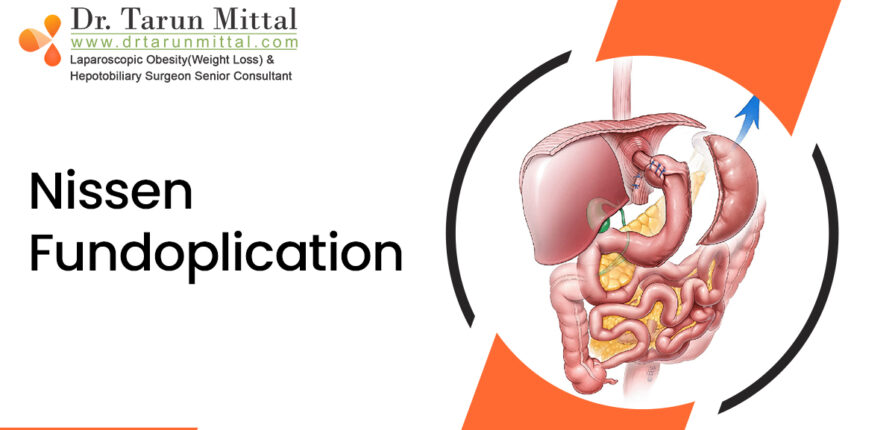Gastroesophageal reflux disease (GERD) is a common digestive disorder characterized by the backward flow of stomach acid into the oesophagus, leading to symptoms such as heartburn, regurgitation, and chest pain. While lifestyle modifications and medication can often alleviate mild GERD symptoms, some individuals may require surgical intervention for long-term relief. One such surgical procedure is Nissen fundoplication, which aims to address the underlying cause of GERD and restore normal function to the oesophagus. Dr Tarun Mittal, the Best Laparoscopic surgeon in Sir Ganga Ram Hospital, describes the procedure of Nissen Fundoplication and how it could treat various complications related to GERD. With years of experience and thousands of happy patients, Dr Mittal has earned the reputation as the Best Laparoscopic surgeon in Sir Ganga Ram Hospital. In this blog, we’ll explore what Nissen fundoplication entails, how it treats GERD, and what patients can expect from the procedure.
What is Nissen Fundoplication?
Nissen fundoplication is a surgical procedure used to treat GERD by strengthening the lower oesophagal sphincter (LES) and preventing the reflux of stomach acid into the oesophagus. Named after Dr Rudolph Nissen, who first described the procedure in the 1950s, Nissen fundoplication involves wrapping the upper part of the stomach (the fundus) around the lower oesophagus and suturing it in place. This creates a valve-like mechanism that helps prevent acid reflux and promotes the proper function of the LES.
How Does Nissen Fundoplication Treat GERD?
Reinforcing the Lower Esophageal Sphincter (LES): In individuals with GERD, the LES may be weak or dysfunctional, allowing stomach acid to flow back into the oesophagus. Nissen fundoplication strengthens the LES by creating a mechanical barrier that prevents acid reflux and reduces GERD symptoms.
Reducing Acid Reflux: By wrapping the upper part of the stomach around the lower oesophagus, Nissen fundoplication helps create a tighter seal at the gastroesophageal junction, minimizing the backflow of stomach acid and bile into the oesophagus.
Restoring Esophageal Function: Chronic acid reflux can lead to inflammation, irritation, and damage to the oesophagal lining. Nissen fundoplication aims to alleviate GERD symptoms and promote healing of the oesophagus, restoring normal function and improving the quality of life for patients.
The Nissen Fundoplication Procedure
During Nissen fundoplication, the patient is placed under general anaesthesia, and small incisions are made in the abdomen to access the stomach and oesophagus. The upper part of the stomach (the fundus) is then wrapped around the lower oesophagus, creating a 360-degree wrap or “floppy” Nissen wrap. The wrap is secured in place with sutures, and any excess stomach tissue is trimmed. Dr Mittal, the best Laparoscopic surgeon in Sir Ganga Ram Hospital mentions that the procedure typically takes about 1-2 hours to complete, and patients may require a short hospital stay for monitoring and recovery.
Recovery and Long-Term Outcomes
After Nissen fundoplication, patients can expect some discomfort and swelling at the incision sites, which typically resolves within a few days. Most patients can resume normal activities within 1-2 weeks, although strenuous exercise and heavy lifting should be avoided during the initial recovery period. While Nissen fundoplication is generally effective in relieving GERD symptoms, some patients may experience side effects such as difficulty swallowing (dysphagia) or bloating in the weeks following the procedure. These symptoms usually improve with time and dietary modifications, but patients should follow up with their surgeon for ongoing monitoring and management.
Conclusion
Nissen fundoplication is a surgical procedure used to treat GERD by strengthening the lower oesophagal sphincter and preventing the reflux of stomach acid into the oesophagus. By creating a mechanical barrier at the gastroesophageal junction, Nissen fundoplication helps alleviate GERD symptoms and improve the quality of life for patients. While the procedure may involve some risks and side effects, it offers long-term relief for individuals with persistent or severe GERD that do not respond to conservative treatments. Patients considering Nissen fundoplication should consult with the Best Laparoscopic surgeon in Sir Ganga Ram Hospital, i.e., Dr Tarun Mittla to discuss the risks, benefits, and potential outcomes of the procedure based on their individual needs and medical history.


